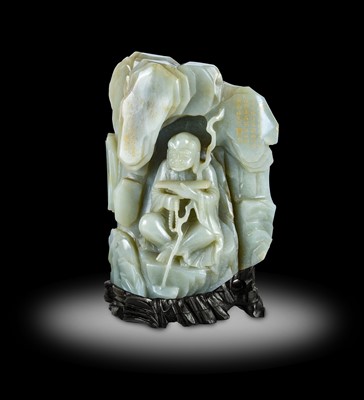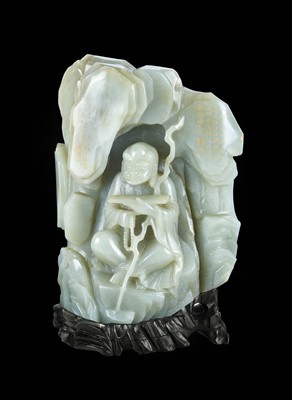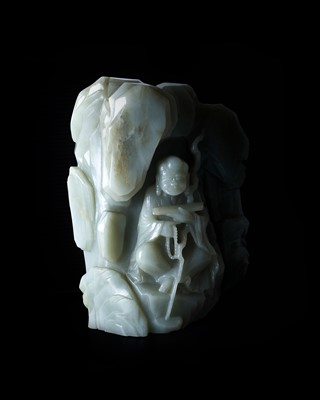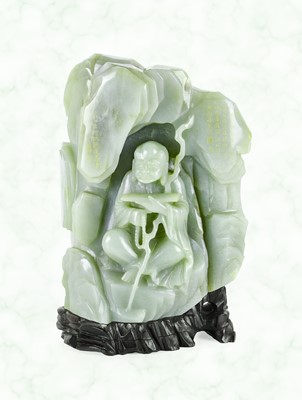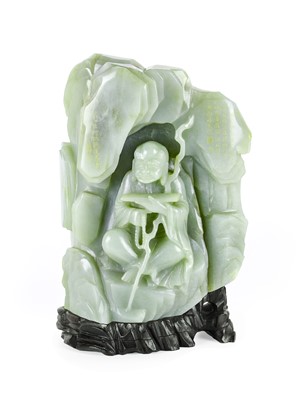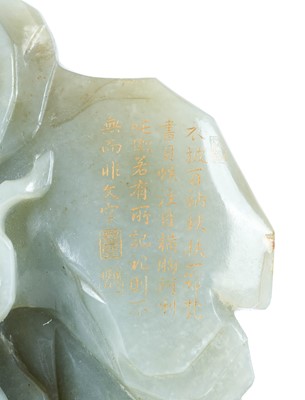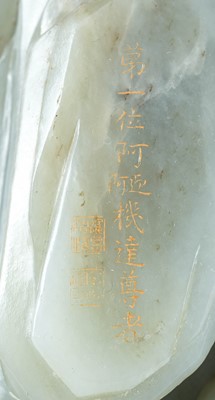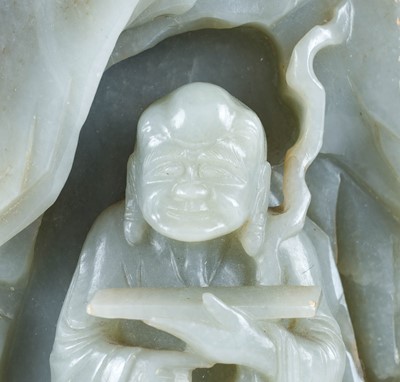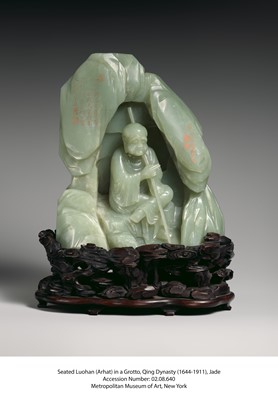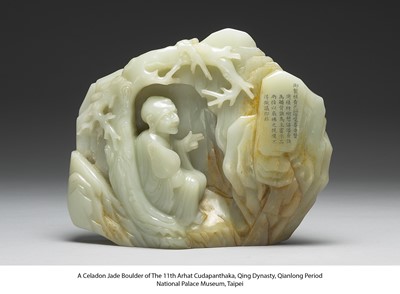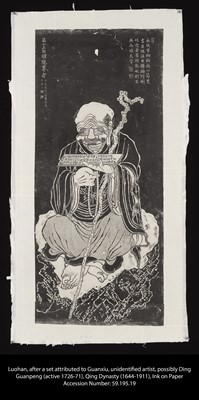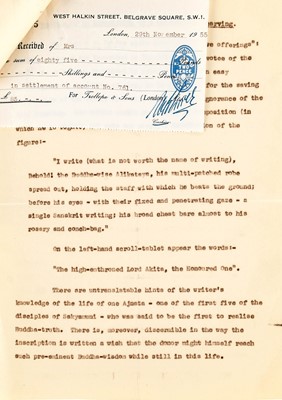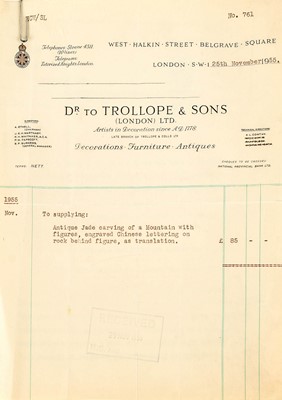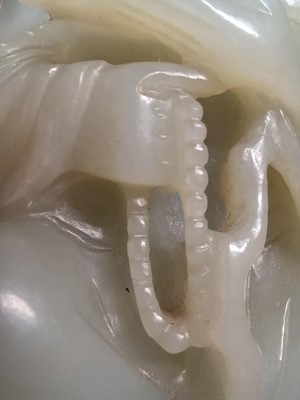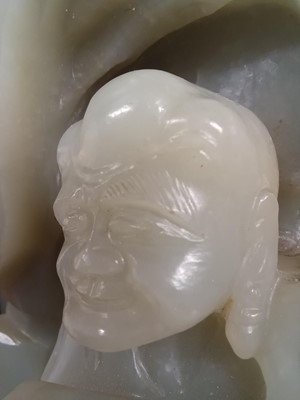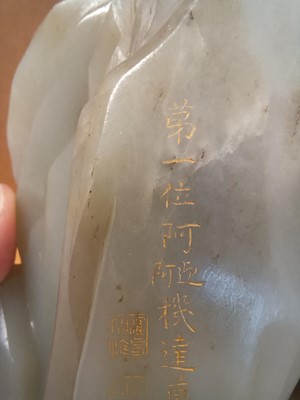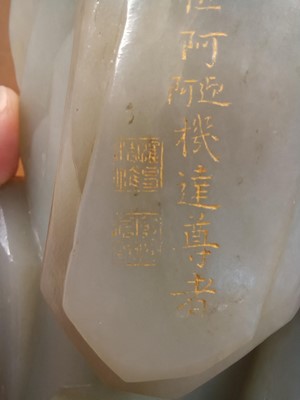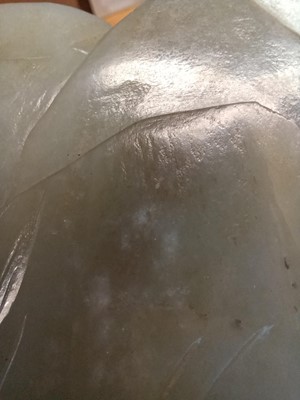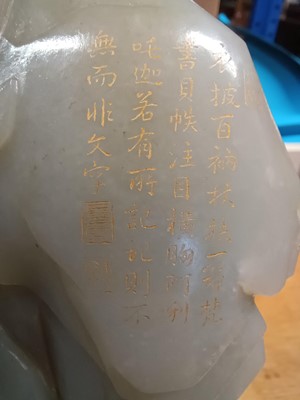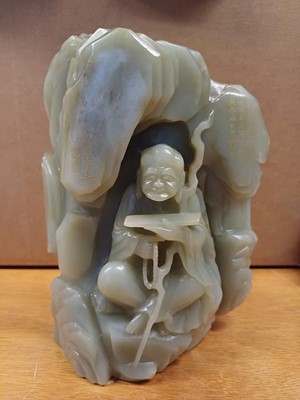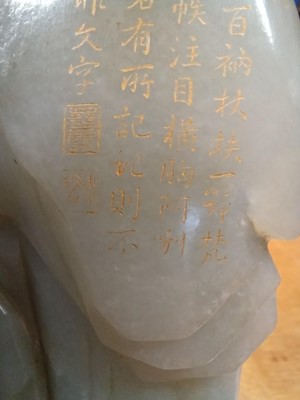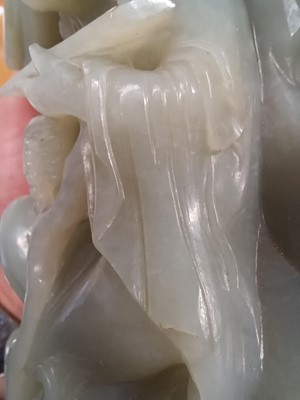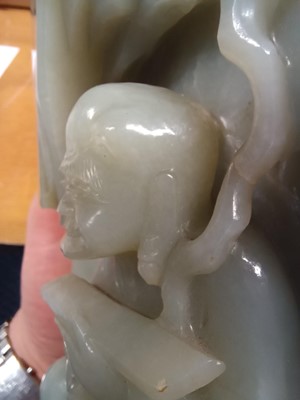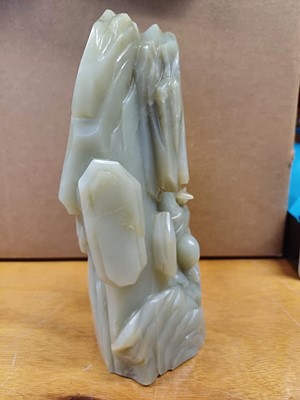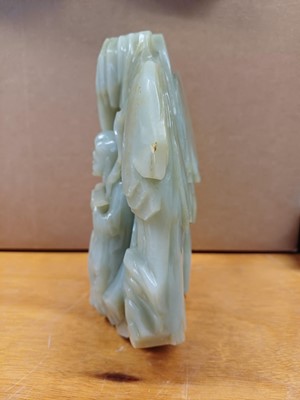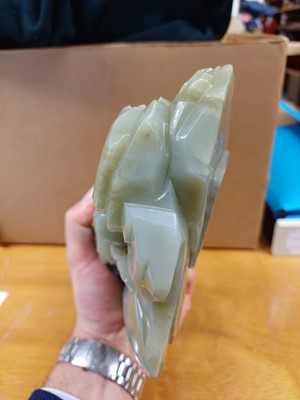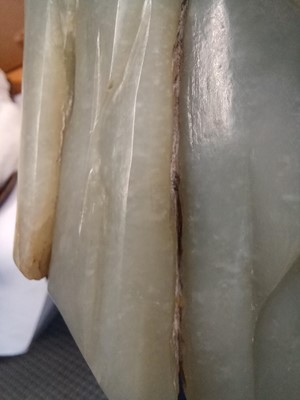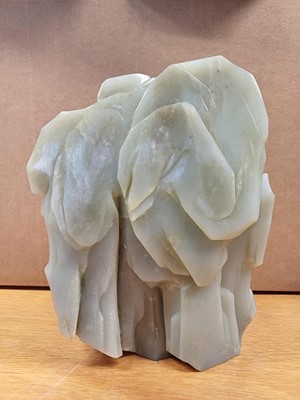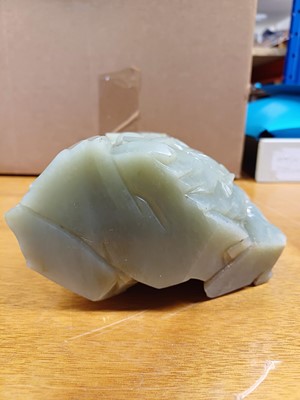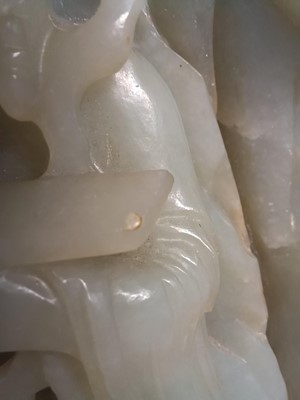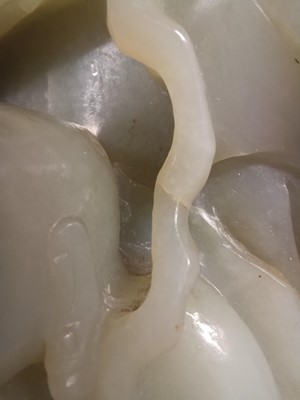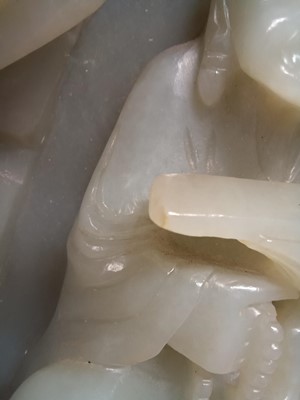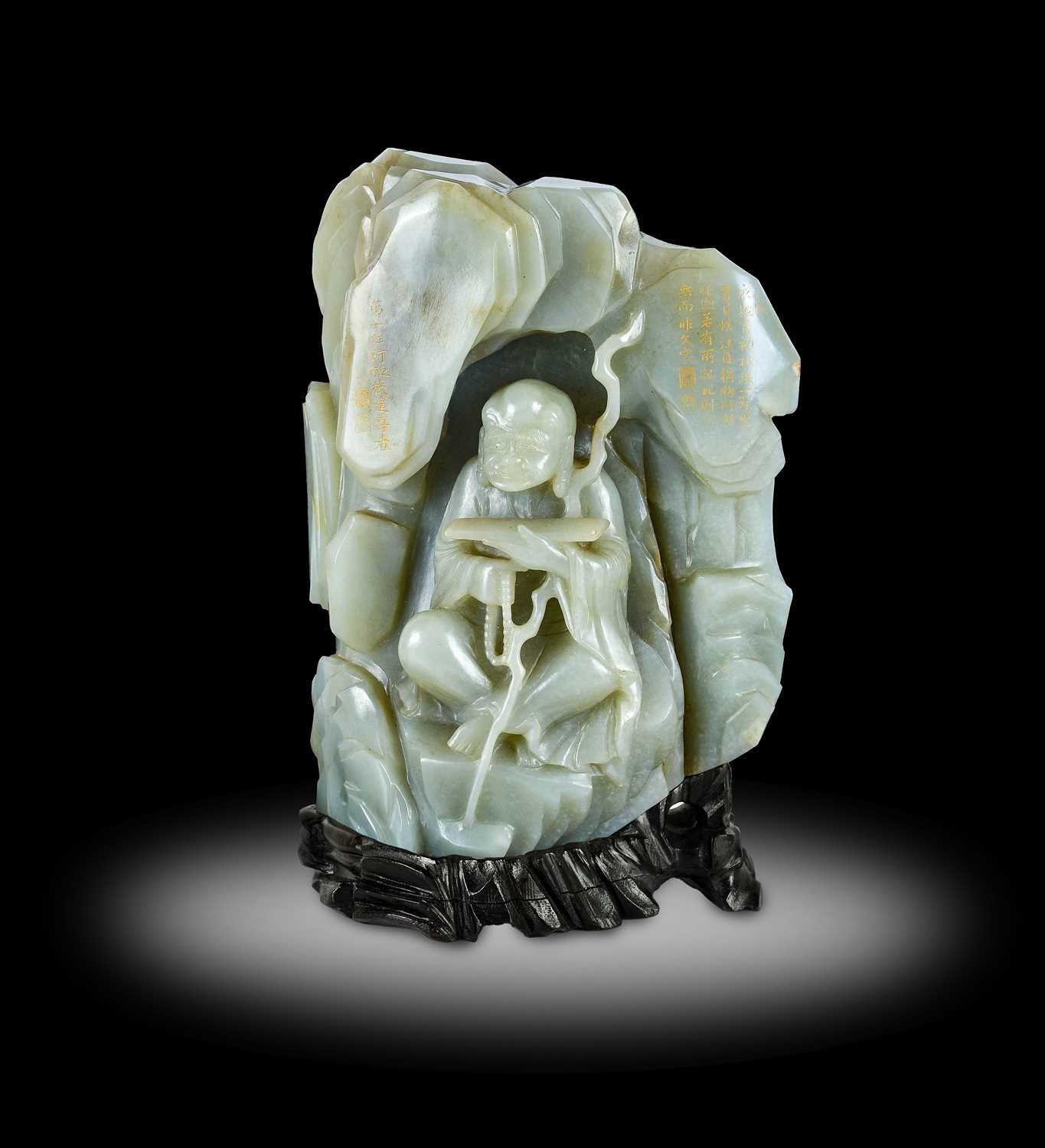16th Mar, 2024 9:30 GMT/BST
Spring Fine Sale
5
~ A Chinese Celadon Jade Inscribed “Luohan” Boulder, Qianlong, carved with Ańgaja in a grotto, seated cross-legged in loose flowing robes, his left hand holding a sutra and walking stick, the right counting prayer beads, flanked by the Imperial eulogy and seal marks
20cm high
With original receipt from Trollope & Sons (London) Ltd, West Halkin Street, London dated 25 November 1955 for £85, as well as a transcription of the eulogy
The inscription can be translated as “Wearing a hundred-patch robe and leaning on a proper bamboo staff, his Vedic ritual texts in a bookcase, he stares at his akshamalika straight across his chest. What he has remembered is not nothing, although there are no words for it.”
The iconography of this depiction of Ańgaja is derived from the portrait series of the sixteen Luohans painted in 891 by the Tang dynasty painter-poet-monk, Guanxiu for the Shengyinsi or 'Temple of Sage Reason'; the temple was later destroyed during the Taiping Rebellion. In this series the artist depicted the enlightened disciples with grotesque bodies, hunched backs, bushy eyebrows, and pronounced foreheads, as they had allegedly appeared to him in a dream.
In 1757, the Qianlong Emperor visited the Shengyin Temple during his Southern inspection tour to study these images of the Luohan as an act of religious devotion. He recorded that, having seen the masterpieces, he was inspired to personally write a eulogy comprising two colophons for each painting. The Emperor believed the paintings to be the same set that had been recorded in the Xuanhe Huapu [The Xuande catalogue of paintings], the inventory of the Song dynasty emperor Huizong.
Subsequently, Qianlong commanded the palace painting master, Ding Guanpeng (act.1708-ca.1771) to copy the paintings and to include new inscriptions of the eulogies. Ding’s copies are now in the collection of the National Palace Museum, Taipei and were widely copied in various media.
In 1764, the abbot at Shengyin Temple, Master Mingshui, instructed local stone engravers to copy Guanxiu’s paintings and the Emperor’s colophons and seals. The sixteen engraved stone panels were installed on the sixteen sides of the Miaoxiang Pagoda in Hangzhou. Almost immediately rubbings of the panels were being produced. Knowing the Emperor’s fondness for them, in 1778, the military governor of Shandong province, Guotai (d.ca.1782), presented the Qianlong Emperor with a magnificent zitan folding screen set with black lacquer panels inlaid with white jade in imitation of the rubbings.
A similar jade boulder, depicting the second Luohan, Kanakavasta, was recorded in the collection of the Wou Lien-Pai Museum as published in Rose Kerr et al., Chinese Antiquities from the Wou Kiuan Collection, Surrey, 2011, pl. 177 (fig. 2).
Another example depicting Kanaka is in the Metropolitan Museum of Art, New York, accession number 02.18.640 and a further example as Cudapanthaka is in the National Palace Museum, Taipei.
A sixteen-fold screen with inlaid jade plaques portraying the sixteen luohans, including a depiction of Angaja derived from the same source as the present jade, dated to the forty-second year of the Qianlong reign (1777) is in the Palace Museum, Beijing, exhibited at the Hong Kong Museum of Art (22 June 2012 - 14 October 2012), and illustrated in A Lofty Retreat from the Red Dust: The Secret Garden of Emperor Qianlong, Hong Kong, 2012, pp.216-233, no.53.
A Qianlong Imperial jade screen with the same image of Ańgaja and inscribed with the same script and seals as the present examples was offered by Bonhams Hong Kong, 24 November 2012, lot 307 and Christie’s Hong Kong, 29 November 2022, lot 3049.
Please note that there will be no internet bidding on this lot. All bidders on lots 1-10 will be required to provide identification and a deposit of £1,000. Registration for commission and telephone bidding on these lots will close on Wednesday 13th March at 12 noon. To register please email enquiry@tennants-ltd.co.uk
Sold for £88,000
Estimated at £70,000 - £100,000
A natural internal small crack towards the top section of the staff. Sutra with tiny corner flakes. Other minimal small imperfections to the stone, none detrimental. Slight wear to the gilt inscrpitions.
We are happy to provide Condition Reports to prospective buyers, but would welcome your request as soon as possible, preferably at least 48 hours before the Day of Sale. We cannot guarantee a reply to any requests made within 48 hours of the start of the auction. The absence of a Condition Report from a lot does not mean that the lot is in perfect condition. A Condition Report is an honest expression of our opinion, not a statement of fact and is provided as a service to the seller. All lots are available on public view ahead of an auction and we encourage prospective buyers to inspect an item in person where possible. Our Condition Reports are not prepared by professional conservators, restorers, or engineers, and are prepared with the naked eye unless otherwise stated.
Regarding Pictures, Prints and Works on Paper, works are not examined out of the frame, unless specifically stated. Tennants Auctioneers do not cover damage to gilded wood or plaster picture frames, or to picture frame glass whilst the item is in our possession.
We accept no liability for the opinions expressed in any Condition Report.
Auction: Spring Fine Sale, 16th Mar, 2024
This Spring, Tennants Auctioneers is delighted to be offering for sale a fine and rare Chinese Celadon Jade Inscribed ‘Luohan’ Boulder from the Qianlong reign with its original hardwood stand. It will be sold as part of a Private Collection of Asian Art and European Antiques in the sale. The boulder, which is offered with an estimate of £70,000-100,000 plus buyer’s premium, depicts Luohan Ańgaja sitting cross-legged in a rocky grotto. View Press Release
Further highlights from the collection include a Set of Four Chinese Pale Celadon Jade Bowls, Qing Dynasty, probably Qianlong (estimate: £8,000-12,000 plus buyer’s premium), and a Pair of Chinese Porcelain ‘Nodding Head’ Figures, Qianlong (estimate: £4,000-6,000 plus buyer’s premium).
The collectors lived in London from the 1950s and acquired the fine collection predominantly from the leading Asian art and antiques dealers in the city. Many of the pieces in the collection will be sold with original purchase receipts. The items in this collection will be denoted throughout the online catalogue with a ~ symbol.
The sale will also include selected contents from Dutton Manor, Lancashire.
In addition the sale comprises a small family collection of Renaissance bronzes, two good Iznik Faience Dishes from the late 16th/early 17th century, and a Private Collection of 17th and 18th century furniture including Continental and English oak pieces.
Viewing
Sunday 10 March - Friday 15 March 11am-4pm, and morning of sale from 8am
Sell one like this
If you've got a similar item to sell, complete the valuation form below and one of our experts will get in touch.

